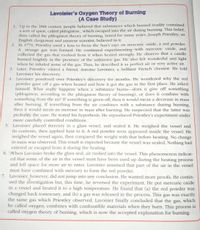
Applications and Investigations in Earth Science (9th Edition)
9th Edition
ISBN: 9780134746241
Author: Edward J. Tarbuck, Frederick K. Lutgens, Dennis G. Tasa
Publisher: PEARSON
expand_more
expand_more
format_list_bulleted
Question
thumb_up100%
- Priestly shared with Lavoisier his discovery of a “perfect air”. Which of the scientific traits did Priestly exhibit in this paragraph ? Choose one trait only. How is the trait used in science?
A. patience
B. gratitude
C. open-mindedness
D. acceptance of failure
- State the problem that Lavoisier decided to investigate.
- State the Hypothesis
- Which paragraph described the experiment that Lavoisier performed to test his hypothesis? Give only the number of the paragraph.
5. In paragraph number 6 why did air rush into the vessel when Lavoisier broke the glass seal?
6. Which paragraph shows Lavoisier’s INTERPRETATION of his OBSERVATIONS. Give only the number of the paragraph.
- What conclusion did Lavoisier draw from his investigation?

Transcribed Image Text:Lavoisier's Oxygen Theory of Burning
(A Case Study)
1. Up to the 18th century people believed that substances which burned readily contained
a sort of spirit, called phlogiston , which escaped into the air during burning. This belief,
then called the phlogiston theory of burning, lasted for many years. Joseph Priestley, an
English clergyman and amateur scientist, believed in it.
In 1774, Priestley used a lens to focus the Sun's rays on mercuric oxide, a red powder.
strange gas was formed. He continued experimenting with mercuric oxide, and
collected the gas that evolved from it when heated strongly. He observe that a candle
burned brightly in the presence of the unknown gas. He also felt wonderful and light
when he inhaled some of the gas. Thus, he described it as perfect air or very active air.
3. Later, Priestley visited a friend, Antoine Lavoisier, a brilliant French chemist. He told
Lavoisier his discovery.
4. Lavoisier pondered over Priestley's discovery for months. He wondered why the red
powder gave off a gas when heated and how it got the gas in the first place. He asked
himself. What really happens when a substance burns-does it give off something
(phlogiston, according to the phlogiston theory of burning), or does it combine with
something from the air? If something is given off, then it would mean a decrease in mass
after burning. If something from the air combines with a substance during burning,
then it would mean an increase in mass after burning. He suspected that the latter was
probably the case. He tested his hypothesis. He reproduced Priestley's experiment under
more carefully controlled conditions.
5. Lavoisier placed mercury in a glass vessel, and sealed it. He weighed the vessel and
its contents, then applied heat to it. A red powder soon appeared inside the vessel. He
weighed the vessel again, then compared the weight with that before heating. No change
in mass was observed. This result is expected because the vessel was sealed. Nothing had
entered or escaped from it during the heating.
6. When Lavoisier broke the glass seal, air rushed into the vessel. This phenomenon indicat-
ed that some of the air in the vessel must have been used up during the heating process
and left space for more air to enter. Lavoisier assumed that part of the air in the vessel
must have combined with mercury to form the red powder.
7. Lavoisier, however, did not jump into any conclusion. He wanted more proofs. He contin-
ued the investigation but, this time, he reversed the experiment. He put mercuric oxide
in a vessel and heated it to a high temperature. He found that (a) the red powder was
changed back tomercury, and (b) a gas was released in the process. This gas was exactly
the same gas which Priestley observed. Lavoisier finally concluded that the gas, which
he called oxygen, combines with combustible materials when they burn. This process is
called oxygen theory of burning, which is now the accepted explanation for burning.
2.
Expert Solution
This question has been solved!
Explore an expertly crafted, step-by-step solution for a thorough understanding of key concepts.
This is a popular solution
Trending nowThis is a popular solution!
Step by stepSolved in 3 steps

Knowledge Booster
Recommended textbooks for you
 Applications and Investigations in Earth Science ...Earth ScienceISBN:9780134746241Author:Edward J. Tarbuck, Frederick K. Lutgens, Dennis G. TasaPublisher:PEARSON
Applications and Investigations in Earth Science ...Earth ScienceISBN:9780134746241Author:Edward J. Tarbuck, Frederick K. Lutgens, Dennis G. TasaPublisher:PEARSON Exercises for Weather & Climate (9th Edition)Earth ScienceISBN:9780134041360Author:Greg CarbonePublisher:PEARSON
Exercises for Weather & Climate (9th Edition)Earth ScienceISBN:9780134041360Author:Greg CarbonePublisher:PEARSON Environmental ScienceEarth ScienceISBN:9781260153125Author:William P Cunningham Prof., Mary Ann Cunningham ProfessorPublisher:McGraw-Hill Education
Environmental ScienceEarth ScienceISBN:9781260153125Author:William P Cunningham Prof., Mary Ann Cunningham ProfessorPublisher:McGraw-Hill Education Earth Science (15th Edition)Earth ScienceISBN:9780134543536Author:Edward J. Tarbuck, Frederick K. Lutgens, Dennis G. TasaPublisher:PEARSON
Earth Science (15th Edition)Earth ScienceISBN:9780134543536Author:Edward J. Tarbuck, Frederick K. Lutgens, Dennis G. TasaPublisher:PEARSON Environmental Science (MindTap Course List)Earth ScienceISBN:9781337569613Author:G. Tyler Miller, Scott SpoolmanPublisher:Cengage Learning
Environmental Science (MindTap Course List)Earth ScienceISBN:9781337569613Author:G. Tyler Miller, Scott SpoolmanPublisher:Cengage Learning Physical GeologyEarth ScienceISBN:9781259916823Author:Plummer, Charles C., CARLSON, Diane H., Hammersley, LisaPublisher:Mcgraw-hill Education,
Physical GeologyEarth ScienceISBN:9781259916823Author:Plummer, Charles C., CARLSON, Diane H., Hammersley, LisaPublisher:Mcgraw-hill Education,

Applications and Investigations in Earth Science ...
Earth Science
ISBN:9780134746241
Author:Edward J. Tarbuck, Frederick K. Lutgens, Dennis G. Tasa
Publisher:PEARSON

Exercises for Weather & Climate (9th Edition)
Earth Science
ISBN:9780134041360
Author:Greg Carbone
Publisher:PEARSON

Environmental Science
Earth Science
ISBN:9781260153125
Author:William P Cunningham Prof., Mary Ann Cunningham Professor
Publisher:McGraw-Hill Education

Earth Science (15th Edition)
Earth Science
ISBN:9780134543536
Author:Edward J. Tarbuck, Frederick K. Lutgens, Dennis G. Tasa
Publisher:PEARSON

Environmental Science (MindTap Course List)
Earth Science
ISBN:9781337569613
Author:G. Tyler Miller, Scott Spoolman
Publisher:Cengage Learning

Physical Geology
Earth Science
ISBN:9781259916823
Author:Plummer, Charles C., CARLSON, Diane H., Hammersley, Lisa
Publisher:Mcgraw-hill Education,